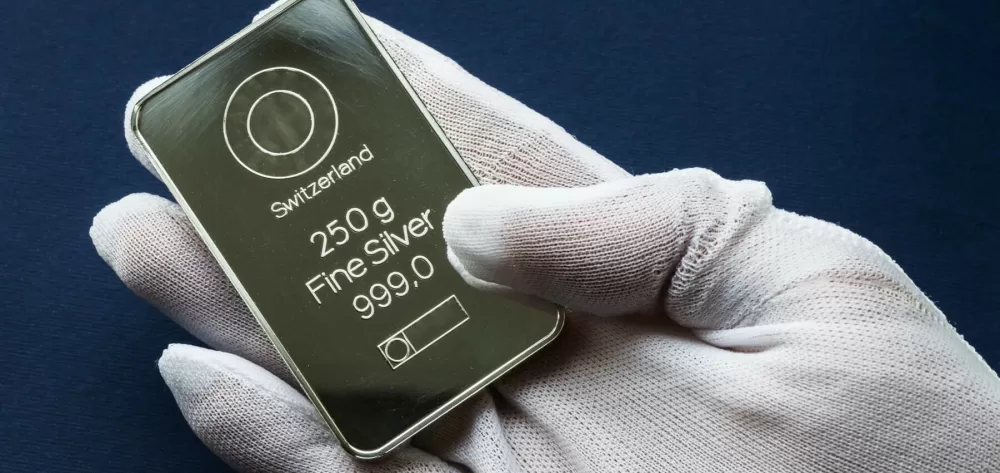Like other precious metals, silver can be used to diversify your personal investment portfolio. This moneyland.ch guide lists the most important options you can choose from for investing in “poor man’s gold.”
1. Silver bullion
Buying actual raw materials in the form of bullion is the original and most traditional way to invest in silver. The advantage of buying silver bullion is that you actually own the precious metal. But there are also disadvantages that you should consider. Firstly, you have to pay value-added tax (VAT) when you buy physical silver. Secondly, holding silver bullion does not yield interest or dividends. Storage fees must also be accounted for when calculating potential returns. One of the most important things to do when buying silver bullion is to compare the prices charged by different dealers. In Switzerland, silver prices can vary substantially from one dealer to another. Always include Degussa, Geiger, Pro Aurum, Philoro, and a variety of banks in your price comparisons. You can find more information in the guide to buying silver in Switzerland.
2. Precious metal accounts
Using a precious metal account is a simple alternative to buying physical silver. Your silver is held in a silver-denominated bank account, which has both advantages and disadvantages. You do not have storage costs, like you would with physical silver, but you pay ongoing account fees. Depending on which precious metal account you use, the fees can be very high. You do not earn interest on your account balance. Some banks give you the option of withdrawing your silver in bullion form, but you generally pay additional fees for physical withdrawals. You can find a full overview of the pros and cons in the guide to Swiss precious metal accounts.
3. Silver ETFs
A flexible solution for investing in precious metals like silver is to use exchange-traded funds (ETFs) – in this case, ETFs dedicated to silver. These are passive index funds, the shares of which are traded on stock exchanges. Silver ETFs invest in silver with the aim of replicating the silver spot price as accurately as possible. In order to invest in silver ETFs, you must have a custody account with a retail bank or with an online stock broker. You should take time to compare the custody fees and brokerage fees charged by different banks for buying and holding ETF shares. The online trading comparison on moneyland.ch makes it easy to find the cheapest Swiss online trading platform for your investment needs.
You should also look at the total expense ratios (TERs) of different silver ETFs themselves. The table below lists all of the ETFs that meet these criteria: The ETF is domiciled in Switzerland; the ETF is quoted in Swiss francs; the ETF holds actual, physical silver and not silver derivatives; the ETF’s shareholders have the option of withdrawing their share of silver from the fund in the form of standardized silver bars (1000 fine ounces, which is approximately 30 kilograms).
Table 1: Swiss silver ETFs in CHF (physical price replication)
| Exchange-traded fund |
ISIN |
TER |
CHF Performance |
Currency hedging |
| ZKB Silver ETF AA (CHF) |
CH0183135976 |
0.60% |
5.53% |
No |
| ZKB Silver ETF AAH (CHF) |
CH0183136024 |
0.60% |
-15.45% |
Yes |
Swisscanto ETF Precious Metal
Physical Silver A (CHF) |
CH0106405894 |
0.68% |
-15.55% |
Yes |
| Silver spot price (converted into CHF) |
|
|
18.47% |
|
The performance figures in Table 1 indicate changes in the value of the investment over the past ten years, in Swiss francs. They are calculated based on the closing prices of the first trading days in August 2013 and August 2023. The silver spot price performance figure is based on the London Bullion Market Association (LBMA) closing prices on the same dates.
The figures above show that Swiss ETFs with currency hedging performed exceptionally poorly over the past ten years.
4. Silver ETCs
Exchange-traded commodities (ETCs) are certificates that are traded on stock exchanges. Unlike ETFs, ETCs are simply debt claims against an ETC issuer. If an ETC’s issuer were to become insolvent, ETC certificates would not qualify as segregated assets and this are not secured, so you carry the issuer risk. It is also important to note that there are no silver ETCs that are domiciled in Switzerland. An important criterion to look at when considering an ETC is whether or not it is backed by physical commodities – meaning its issuer actually holds enough physical silver in reserve to cover the value of its certificates. Completely collateralized ETCs, on the other hand, are not backed by physical commodities, but by debt claims.
| Exchange-traded commodity |
ISIN |
TER |
Performance in CHF |
| Invesco Physical Silver ETC |
IE00B43VDT70 |
0.19% |
7.73% |
| WisdomTree Physical Silver ETC |
JE00B1VS3333 |
0.49% |
-3.61% |
| Xtrackers Physical Silver ETC (EUR) |
DE000A1E0HS6 |
0.45% |
10.16% |
| Silver spot price |
|
|
16.07% |
The performance figures above indicate developments in the value of ETCs over the past ten years, in Swiss francs. The calculation is based on the closing prices on the first trading days of August 2013 and August 2023. The silver spot price is calculated based on the LBMA closing prices on the same dates.
5. Silver futures
Silver futures are contracts with which you agree to buy silver, but only at a later date in the future. In the standard use case, the buyer in a futures contract believes that the silver price will go up, so that they will make a return on top of the price they agree to pay for the silver. The seller, on the other hand, believes that the price of silver will go down, so that the price they are paid as per the contract is higher than the going silver price at the time that the transaction takes place. In most cases, only the ownership of the silver changes hands, and not the physical silver itself.
When you enter into a futures agreement, you have to put down collateral to create a margin. The collateral must be equal to a predefined portion of the contract’s value. While the resulting leverage effect makes it possible to earn high returns in an uncomplicated way and with relatively little initial capital, using futures can also result in high losses, which makes them unsuitable for new investors.
6. Individual stocks
Buying shares in individual companies is another way to participate in the silver market without buying actual, physical silver. For example, you can invest in companies that operate silver mines. Examples of silver mining companies whose stocks are listed on stock exchanges include Fresnillo plc (United Kingdom), Pan American Silver, and First Majestic Silver (both from Canada). You can buy shares in companies like this directly at a bank using a custody account, or using an online stock broker.
Over the short term, you may be able to earn higher returns. Additionally, shares in companies may yield dividends, unlike physical silver. But it is important to remember that investing in a single company brings with it a lot of risk. This is especially true of companies in the volatile commodities industry sector. On top of that, there is also a substantial operational risk. The value of a silver-mining company’s stock can go down even when the price of silver is high.
7. Stock ETFs
Stock ETFs offer an alternative to investing in individual companies in the silver business. But the frequently-cited advantage that passive investment funds let you diversify your investment is less significant in this case. While ETFs make it easy to invest in many different companies, instead of just one, stock ETFs that specialize in the silver business are limited to just one industry sector. If the silver price collapses and the economic situation is poor, even being invested in ETFs will not help you avoid losses. On the other hand, there is also the possibility that you will earn high returns over the short term. Compared to owning shares in individual companies, there is far less operational risk because the ETF invests in many different companies. Another advantage is that you may receive dividends.
Table 3: Selection of silver-themed stock ETFs
| Exchange-traded fund |
ISIN |
TER |
Performance in CHF |
| Global X Silver Miners ETF |
US37954Y8488 |
0.65% |
-36.14% |
| iShares MSCI Global Silver and Metals Miners ETF |
US4642863272 |
0.39% |
-24.89% |
| ETFMG Prime Junior Silver Miners ETF (SILJ) |
US26924G1022 |
0.69% |
-14.14% |
| Silver spot price |
|
|
16.07% |
The performance figures above indicate changes in the value of the ETFs over the past ten years. Calculations are based on the closing prices on the first trading days of August 2013 and August 2023. Developments in the silver sport price are calculated based on the LBMA closing prices on the same dates.
More on this topic:
How to buy physical silver in Switzerland
Compare Swiss online stock brokers now
Guide to buying gold in Switzerland
Factors that affect the gold price explained




